|
|
Jersey Geology Trail |
Andesite. (Germ. andesit = from the Andes Mountains; Gk. lithos=rock). |
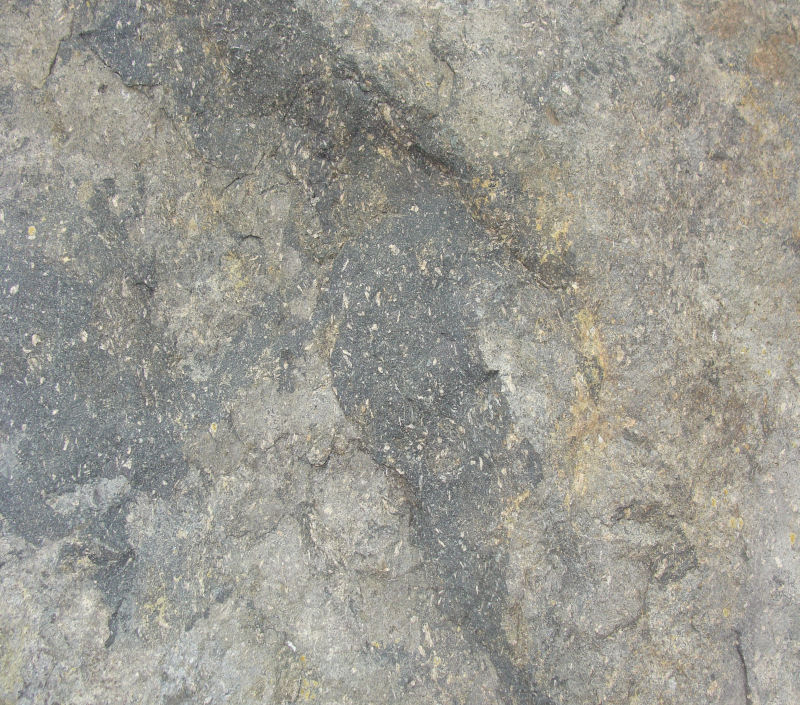 |
Porphyritic andesite, Highlands Quarry, St. Helier. |
| |
Andesite is generally a medium grey, finely crystalline, intermediate volcanic igneous rock composed of variable amounts of the plagioclase feldspars oligoclase to andesine, and the mafic minerals hornblende (an amphibole) and augite (a pyroxene). It may also be porphyritic with feldspar phenocrysts, and vesicular (Allaby & Allaby, 1990, p.23) for example, an outcrop of pillow-like structures in tuff, found in the roadside cutting along Le Mont Sohier, may represent a form of onion weathering but given the keratophyre mineralogy of the andesite, they may have been water lain, though not from lava (Nichols, 2015, p.399).
Andesites make up the lowest formations of the Jersey Volcanic Group and together form the St. Saviour's Andesite Formation which crops out in the Trinity Syncline (a small synclinorium) plunging NNE and the St. Helier Syncline which plunges SSW. Exposures occur on the northern and southern coasts and in isolated areas in a gentle arc across the central part of the island.
In general, the St. Saviour's Andesite lies disconformably on the Jersey Shale Formation but appears conformable in parts. The formation consists of porphyritic andesite lava flows, tuffs and agglomerates and minor basalts, thought to have been deposited subaerially on the flanks of volcanoes possibly to the north-east and south of the present outcrop and in lacustrine and fluvial environments in part and are described as keratophyres (Bishop & Bisson, 1989, p. 13 et seq.).
The volcanic environment has been interpreted as one of a system of arcs (Dupret et al. 1990, p.128, below) similar to that of parts of the Andean region (Brown et al. 1990, p.207-208). |
| |
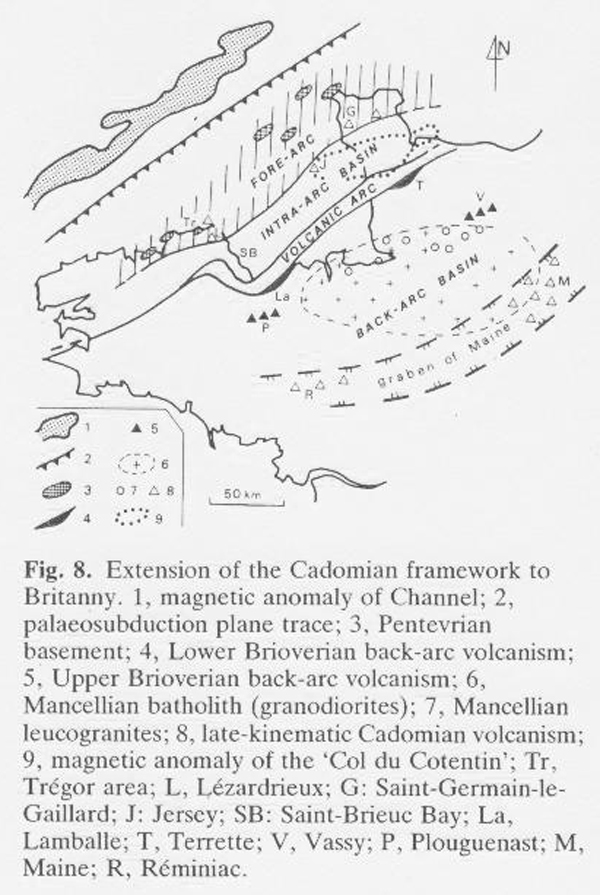 |
| |
The keratophyric mineralogy (albite to oligoclase etc.) is secondary and due to alteration by hydrothermal (hot water) circulation rather than regional metamorphism (op.cit. p.14). This mineralogy is typical of an ocean floor environment (Allaby & Allaby, p. 300-301) which raises some interesting questions, given the field descriptions of the Jersey andesites. Mourant (1933, p.281) also states that certain features (not stated) suggest that they are spilites (though unlike those of the Trégorrois in North Brittanny), but he decided to follow 'the sanction of usage' and refer to them as andesites.
Their age is quoted in two different ways by Bishop & Mourant (1989, p.13 & 59) but a whole rock isochron from andesites immediately west of St. Helier of 522 +/-6 Ma (recalculated from 533 +/-6 Ma) was determined Duff (1978, p.153-156). This was disputed by Bishop & Mourant, (1979, p.121-122) as too old (from other field associations) and they suggested 509 Ma (recalculated from 520 Ma), the age of the nearby Elizabeth Castle granophyre, from which the andesites may have received different material. An even younger date of 477 +/-6 Ma (formerly 470+/-6 Ma) from different andesite was obtained by Allen (1972. p.273-294). Dupret et al (1990, p. 126) quote the older age (see Duff above).
The porphyritic andesites are easily recognised and are medium to dark grey rocks with many large white crystals of plagioclase feldspar. These are of albite composition, c.10mm long and 5mm wide, with ragged ends and are thought to have been altered from an intermediate variety (oligoclase) by hydrothermal action. Much sericite (a muscovite-type hydrous potassium silicate), occurs on altered feldspars and chlorite and epidote occur in the groundmass, all indicating alteration.
The main outcrop area at La Belle Hougue Point on the north coast of Trinity Parish stretches from Giffard Bay to the west via Les Rouaux to Vicard Point on the eastern side. The successions are varied and contain tuffs, andesites, agglomerates and conglomerates with intercalated mudstones overlying the Jersey Shale Formation; drawn sections are clearly presented by Bishop and Bisson (1989, p.16).
The tuffs, for example the Vicard and Long Echet Tuffs, are variable in colour and while the former contains many bombs, the latter contains megacrysts of feldspar and quartz and is more siliceous, exhibiting white strands (fiamme) of granular quartz, and is similar to an ignimbrite.
The agglomerates, for example Les Rouaux and L' Homme Mort Agglomerates, contain fragments of shale, andesite and porphyry, with pumice in the former, set in a felsitic matrix.
In the Trinity Syncline, the boundary between the Jersey Shale Formation and the andesites is exposed around St. Helier at West Hill (vertical junction between shales and tuffs, here considered conformable), Chestnut Farm, Le Clos de Paradis and Wellington Road (faulted junctions).
On the north coast at Le Côtil Point, there are contacts with granite of the Northwest Igneous Complex and with overlying ignimbrites which have been thermally metamorphosed.
South of Handois Reservoir to Le Mont à l'Abbé, the andesites are porphyritic with large albite crystals in a dark grey-green, finely crystalline felsite groundmass. Pseudomorphs of pyroxene occur and mafic crystals are seen to have been replaced (Bishop & Bisson, 1989, p. 21). |
| |
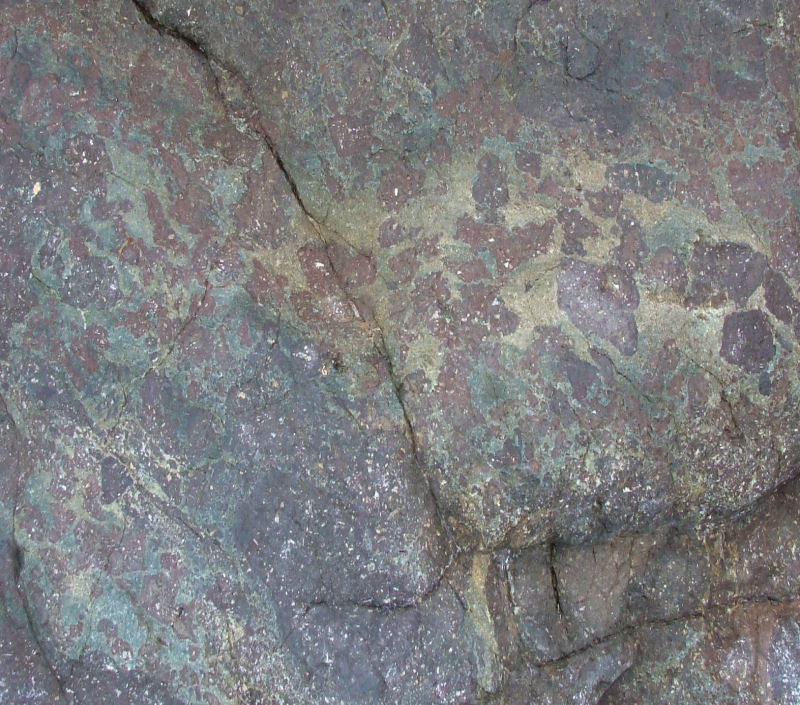 |
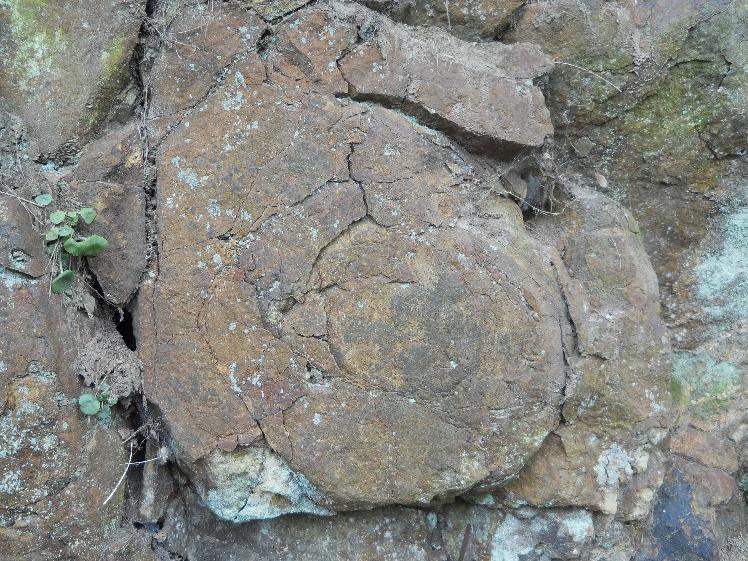 |
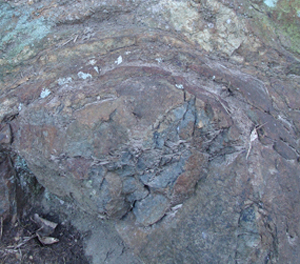 |
Agglomerate unit, amygdales & fluxion,
Havre des Pas sea wall (West Mt. quarry?). |
Pillow-like structures, Le Mont Sohier. |
| |
In La Vallée des Vaux, the authors (loc.cit.) report that two lava flows behind Homestead Cottage, one, dark green and blocky and the other, light green with amygdales (possibly former gas bubbles filled with secondary minerals) may be exhibiting inversion; tuffs occur elsewhere.
{NB. There are two outcrops of altered basalt north of the cottage and another occurs near Stirling Castle by the lane (Le Mont Néron) out of Les Grands Vaux (loc.cit. fig. 6. p. 21). Altered amygdaloidal basalt is also recorded south of Rozel Manor (loc.cit. p. 23)}.
Many other exposures are recorded by the authors with due acknowledgement to the work of other authors (Mourant, 1933; Thomas, 1977). Outcrops occur on New Trinity Hill (green-purple, porphyritic feldspar andesite, fluxion banded); St. Saviour's Hill (grey pyroxene andesite with tuffs, agglomerate and amygdales); St. Mark's School (grey porphyritic feldspar andesite, fluxion banded); Swiss Valley (tuffs, andesite, agglomerate); east of Le Beau Désert on La Rue de la Garenne (thick pyroxene-andesite pebble conglomerate, possibly due to inter-flow erosion); and an inlier around La Blanche Pierre (pyroxene andesite, agglomeratic tuff, and tuffite, a mixture of pyroclasts and weathered /eroded clasts, possibly a lake deposit). |
| |
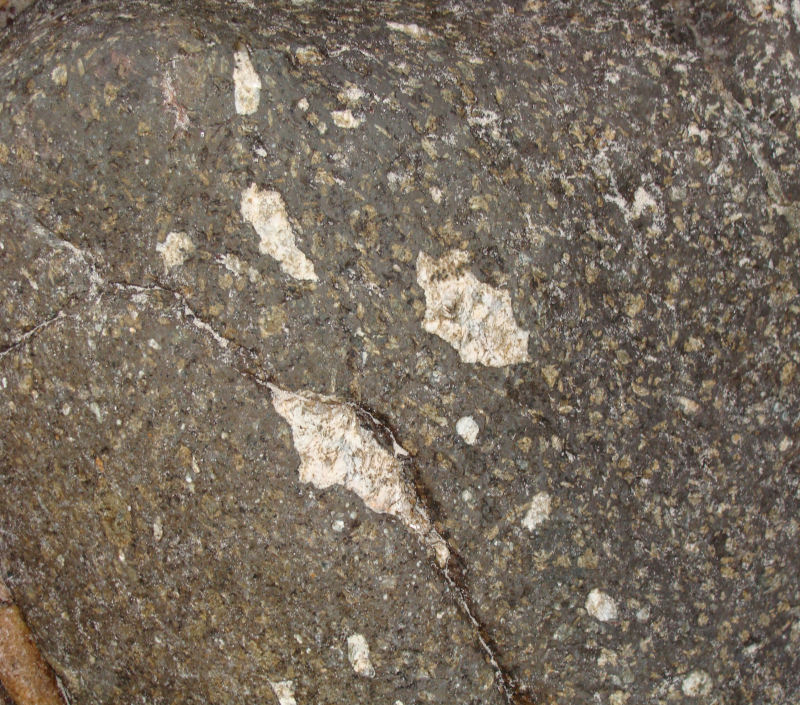 |
|
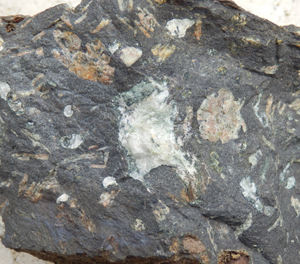 |
Amygdales filled by calcite (A. Hill, pers. comm.), Havre des Pas sea wall, possibly from Westmount Quarry, St. Helier. |
| |
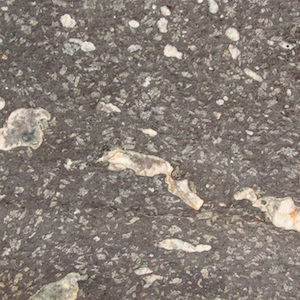 |
|
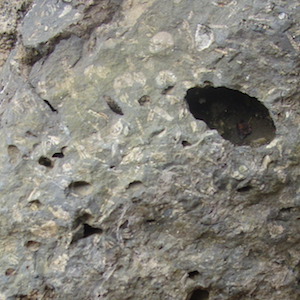 |
Andesite amygdales, Havre des Pas. |
|
Andesite vesicular, St Helier. |
| |
Finally, in the St. Helier Syncline immediately west of St. Helier, which plunges to the SW, the sequence consists of interbedded andesites, agglomerates and tuffs exposed in various quarries, road cuttings near West Park, in West Mount Quarry, St. John's Road and around the Bathing Pool (Victoria Marine Lake). The different members are named from these sites (Bishop & Bisson, 1989, p. 17). Here, fluxion banding, grading and abundant amygdales (photos above) occur indicating a variety of environments, possibly sub-aerial (op. cit. p. 19), although only pillow-like forms have been found and they have previously been described as spilites and keratophyres. The amygdales are described as being infilled with minerals ranging from fibrous chlorite, lined with quartz and sericite and centres of clino-zoisite bordered with epidote (Mourant, 1933, p. 280), and penninite (Bishop & Bisson, 1989, p. 19). |
| |
|
References.
Allaby, A. and Allaby, M. 1990. A Dictionary of Earth Sciences. 2nd. Ed. Oxford University Press.
Allen, P. 1972. Wealden detrital tourmaline: implications for northwestern Europe. Q. J. Geol. Soc. London, Vol. 128, p. 273 - 294.
Bishop, A. G. & Bisson,. G. 1989. Classical areas of British geology: Jersey description of 1:25,000 Channel Islands Sheet 2. (London: HMSO for British Geological Survey).
Bishop, A. C. and Mourant. A. E. 1979. Discussion on the Rb - Sr whole rock age determination of the Jersey Andesite Formation, Jersey. C. I. Journal of the Geological Society, London, 136. p. 121.
Dupret, L., Dissler, E., Dore, F., Gresselin, F., & Le Gall, J. 1990. Cadomian geodynamic evolution in the northeastern Armorican Massif (Normandy & Maine), pp. 115 - 131. In D'Lemos. R. S., Strachan. R. A. and Topley. C. G. Eds. 1990. The Cadomian Orogeny. Geol. Soc. Spec. Publ. No. 51. The Geological Society. London.
Institute of Geological Sciences. 1982. Jersey (Channel Islands Sheet 2). Solid and Drift 1:25,000 Series {see map credits for all the contributors}.
Mourant, A. E. 1933. The geology of eastern Jersey. Q. J. Geol. Soc. London. Vol. 89. pp. 273 - 307.
Nichols, R. A. H. 2015. Rare onion weathering in Jersey rock and the spalling of building materials. Ann. Bull. Soc. Jersiaise. 31. 2. p.398.
Thomas, G. M. 1977. Volcanic rocks and their minor intrusives, eastern Jersey, Channel Islands. Unpublished PhD thesis, University of London. |
| |
| |
| |
|